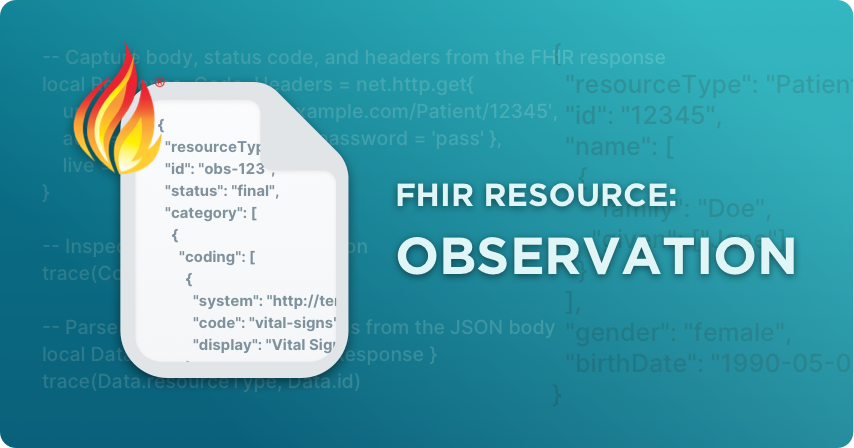
FHIR: Observation Resource
The Observation resource is one of the most frequently used data structures in FHIR. It represents measurements, test results, and other observations made about a patient. These can include vital signs, laboratory test results, imaging interpretations, or even survey responses.
In FHIR, the Observation resource serves as a flexible way to capture clinical facts, providing a common structure for both quantitative and qualitative findings. Because nearly every healthcare system needs to record or exchange patient observations, this resource is essential to interoperability.
Purpose of the Observation Resource
The Observation resource captures the result or value of something observed or measured during the course of care. It can represent a wide range of data, from simple numeric measurements to complex coded results.
Common examples include:
- Laboratory test results (for example, blood glucose level or hemoglobin)
- Vital signs (temperature, pulse, respiration rate, blood pressure)
- Clinical findings (such as a physical exam note)
- Device readings (such as ECG data or heart rate from a monitor)
- Questionnaires or patient-reported data
FHIR allows the Observation resource to represent both diagnostic and non-diagnostic information, making it useful across multiple clinical and research workflows.
Structure of the Observation Resource
Each Observation resource includes details about the observation itself, the subject (typically a patient), the time it was made, and the result value.
Below is an example of a simple Observation in JSON format:
{
"resourceType": "Observation",
"id": "obs-123",
"status": "final",
"category": [
{
"coding": [
{
"system": "http://terminology.hl7.org/CodeSystem/observation-category",
"code": "vital-signs",
"display": "Vital Signs"
}
]
}
],
"code": {
"coding": [
{
"system": "http://loinc.org",
"code": "8867-4",
"display": "Heart rate"
}
],
"text": "Heart rate"
},
"subject": {
"reference": "Patient/12345",
"display": "Jane Doe"
},
"effectiveDateTime": "2025-10-10T09:00:00-05:00",
"valueQuantity": {
"value": 78,
"unit": "beats/minute",
"system": "http://unitsofmeasure.org",
"code": "/min"
}
}This example shows a heart rate measurement. The Observation includes the status, category, measurement code, subject, and result value, all expressed in a standardized way.
Key Elements of the Observation Resource
| Element | Description |
|---|---|
| status | Indicates the state of the observation (for example, 'registered', 'final', or 'amended'). |
| category | Groups the observation by type (such as 'vital-signs' or 'laboratory'). |
| code | Identifies what was observed, often using a terminology system such as LOINC. |
| subject | References the Patient or group the observation applies to. |
| effectiveDateTime | The time when the observation was made. |
| valueQuantity | The measured or observed value (numeric, coded, or text). |
| interpretation | Optional field that indicates clinical meaning (for example, 'high' or 'normal'). |
| referenceRange | Defines the normal or expected range of values, if applicable. |
Relationships to Other FHIR Resources
The Observation resource is often linked to several other resources in FHIR. These relationships provide context and meaning for the data.
| Related Resource | Relationship Description |
|---|---|
| Patient | Identifies the person the observation is about. |
| Encounter | Indicates the visit or event when the observation occurred. |
| Practitioner | The clinician or provider who recorded or verified the observation. |
| Device | The instrument or device that produced the measurement. |
| Specimen | The sample that was tested (for example, blood or urine). |
| DiagnosticReport | Groups related observations into a single report, such as a lab panel. |
Because of these links, Observations play a key role in forming complete clinical narratives within FHIR-based systems.
FHIR Maturity Level
The Observation resource is classified as Normative (FMM level 5) in the FHIR standard. It is one of the most widely implemented resources and serves as a reference model for other clinical resources. This means the structure is stable, well-tested, and backward compatible across FHIR versions.
Coding and Terminologies
Observation resources often use external coding systems to describe what was measured. The most common are:
- LOINC (Logical Observation Identifiers Names and Codes): used for lab and clinical measurements.
- SNOMED CT: used for clinical findings, qualitative results, or concepts not covered by LOINC.
- UCUM (Unified Code for Units of Measure): used for expressing measurement units (such as mmHg or kg).
Using standardized codes ensures that data exchanged between systems has consistent meaning.
Profiles and Extensions for Observations
Many organizations customize the Observation resource through FHIR Profiles and Extensions to reflect their specific workflows or reporting needs. Examples include:
- Adding local codes or units of measure.
- Requiring certain fields for specific observation categories (for example, all vital signs must include a measurement time).
- Adding interpretation notes, comments, or derived values.
These adaptations maintain flexibility while preserving interoperability through standardized profiles.
Real-World Use Cases
Observation resources appear in nearly every FHIR workflow. Common use cases include:
- Laboratory Results Exchange: Mapping HL7 ORU messages to FHIR Observations for lab systems.
- Vital Signs Monitoring: Transmitting temperature, blood pressure, and heart rate data from bedside devices.
- Remote Patient Monitoring: Collecting wearable device data for analysis.
- Population Health and Analytics: Aggregating Observations to support clinical research and public health reporting.
Because Observations represent structured, measurable data, they are central to both operational and analytical healthcare processes.
Other FHIR Resources
Explore other core FHIR resources that work alongside Patient data, such as the Patient and Encounter resources.
Continue reading: FHIR Profiles and Extensions →